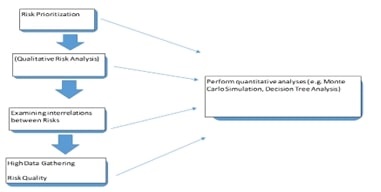Risk Management Considerations for Civil Engineering Consultancy Services in Guyana

Abstract:
Identification of the possible risks
that will affect the projects, knowing them will allow control of these, will
increase the probability of success of the projects, and the level of
confidence of the involved will increase by decreasing the level of uncertainty
of the project. The development of this work is comprised of five phases, first
was a planning to structure the processes to follow evaluating,, stages, then
the risks that will affect the project and their characteristics, the
qualitative analysis was performed, prioritized for actions, evaluating and
estimating their probability of occurrence and their impact, then the plan was
designed for the treatment and response to risks to reduce, retain and transfer
their threats during the development of the project itself and finally give the
guidelines for the monitoring and control of risks. Based on the above, the
following question is generated: What are the risks to consider in consultancy
services for the Project of Construction, to guarantee success in the
execution, monitoring, and control of the same? The purpose of the research
will be to: Analyze qualitatively the risks identified that meet the standards
mandated by the construction oversight body in the construction sector. This
research would have used a qualitative approach by utilizing information
gathered from secondary sources as the main source of data and presented an
office study approach rather than a fieldwork data structure. The result was identifying
Risk Management factors for the Project of Construction to offer a tool that
helps in better decision-making and to establish implementing strategies that
guarantee the fulfillment of the objectives of quality, and costs of the
Project.
References:
[1] Hillson,
D., 2009, Managing risk in projects: Fundamentals of risk management. Gower
Publishing Limited, pp.27-37.
[2] Hillson,
David., 2005, Understanding and managing risk attitudes., pp. 10-18. https://www.kent.ac.uk/scarr/events/finalpapers/Hillson%20+%20Murray-Webster.pdf.
[3] Project
Management Institute., 2007, Construction Extension to the PMBOK Guide. 3rd
Edition. Newtown Square, PA: Project Management Institute.
[4] Chapman,
C.B. and Ward S.C., 2011, Project Risk Management: Process, Techniques, and
Insights. 2nd Edition. John Wiley and Sons.
[5] The
Chartered Institute of Building., 2004, Code of Practice for Project Management
for Construction and Development, Fifth Edition. Place: Wiley Blackwell.
[6] Institution
of Civil Engineers and the Actuarial Profession., 2005, Risk analysis and
management for projects (RAMP). 2nd ed. Institution of Civil Engineers and the
Actuarial Profession. London: Thomas Telford Ltd.
[7] Project
Management Institute (PMI)., 2004, Guide to the Fundamentals of Project
Management (PMBOK Guide), 3rd Edition. Pennsylvania: Project Management
Institute.
[8] Project
Management Institute (PMI)., 2009, Practice Standard for Project Risk
Management, 1st Edition. Pennsylvania: Project Management Institute.
[9] Sachin
Kerur (S.K) and William Marshall (W.M)., 2012, ’Identifying and Managing Risks
in International Construction Projects’, International Review of Law.
[10] Scheule
H. and Rosch D., 2006, Model Risk: Identification, Measurement and Management.
Risks Books.
[11] Nigel
J. Smith, Tony Merna, and Paul Jobling., 2014, Managing Risk in Construction
Projects, Third Edition. Wiley Blackwell.
[12] Pritchard
C. L., 2015, Risk Management: Concepts and Guidance. Fifth Edition. CRC
Press.
[13] Erikson,
P.E. and Westerberg, M., 2011, Effects of Cooperative Procurement Procedures on
Construction Project Performance: A Conceptual Framework. International
Journal of Project Management.
[14] Paul
Goodwin and George Wright., 2004, Decision Analysis for Management Judgement,
Third Edition. Place: John Wiley & Sons, Ltd.
[15] Mark
Velasquez (M.V) and Patrick T. Hester (P.T.H)., 2013, An Analysis of
Multi-Criteria Decision-Makings’, International Journal of Operations
Research Vol. 10, No. 2, 56-66.
[16] John J.
Hampton., 2009, Fundamentals of Enterprise Risk Management: How Top Companies
Assess Risk, Manage Exposures, and Seize Opportunities. American Management
Association.
[17] Pedler,
M., Burgoyne, J. and Boydell, T., 1997, The Learning Company: A Strategy for
Sustainable Development, 2nd Edition. McGraw-Hill, London.
[18] Winch,
G., 2010; Managing Construction Projects. Second Edition. Wiley Blackwell;
UK; Chapter 1: The management of construction projects & Chapter 2: The
context of construction project management.
[19] Smith
N.J., 2007, Engineering Project Management. 3rd Edition, Blackwell
Publishing Ltd, Oxford.
[20] Duncan,
R.B., 1972, ‘Characteristics of Organizational Environments and Perceived
Environmental Uncertainty.’ Administrative Science Quarterly. vol. 17.
[21] Hales,
C., 2001, Managing through Organization. Routledge, London. https://www.google.com.br/books/edition/Managing_Through_Organisation/d9MNAAAAQAAJ?hl=pt.
[22] Carroll,
A.B., 1989, Business and Society: Ethics and Stakeholder Management.
Southwestern, Cincinnati, OH. https://nibmehub.com/opacservice/pdf/.
[23] Lavanya,
N. & Malarvizhi, T. 2008. Risk analysis and management: a vital key to
effective project management. Paper presented at PMI® Global Congress 2008—Asia
Pacific, Sydney, New South Wales, Australia. Newtown Square, PA: Project
Management Institute.
[24] Dziadosz,
A. and Rejment, M. 2015, Risk Analysis in Construction Project - Chosen Methods.
December 2015. Procedia Engineering 122:258-265
[25] Hurtado,
J. (2008). The Research Project (6th ed.). Caracas: Fifth Edition.

